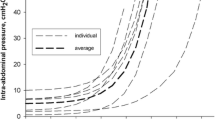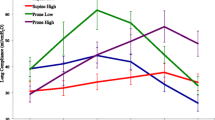Abstract
Objective
To investigate whether negative extra-abdominal pressure (NEXAP) improves respiratory function and induces a blood shift from the intrathoracic compartment and to assess whether these effects are influenced by abdominal pressure.
Design and setting
Prospective, randomized, controlled trial in the animal laboratory of a university hospital.
Subjects
Eight sedated and paralyzed pigs (19.6±3.4 kg).
Interventions
Application of NEXAP (−20 cmH2O).
Measurements and results
Airway, esophageal, gastric and central venous pressures were recorded simultaneously. Intrathoracic blood volume was assessed by PiCCO. The effects of NEXAP were assessed with and without abdominal hypertension by intraperitoneal insufflation of helium. NEXAP caused a lasting drop of gastric (1.97±2.26 mmHg) and esophageal (1.21±0.67 mmHg) pressures, while end-expiratory airway pressure was similar, hence transpulmonary pressure increased. Intrathoracic blood volume dropped from 358±47 to 314±47 ml. The fall was associated with a decrease in central venous pressure (R2=0.820). When peritoneal pressure was raised (24.7±5.5 mmHg), the effects were less marked. However, the difference between negative pressure around the abdomen and the pressure inside the abdomen (effective NEXAP) was correlated with the proportional changes in intrathoracic blood volume (R2=0.648), being greater with more negative effective NEXAP. NEXAP improved chest wall elastance during abdominal hypertension (from 0.067±0.023 to 0.056±0.021 cmH2O/ml).
Conclusions
NEXAP increases lung volume and causes a shift of blood from the intrathoracic compartment. It needs to be tailored against abdominal pressure to be effective




Similar content being viewed by others
References
Valenza F, Bottino N, Canavesi K, Lissoni A, Alongi S, Losappio S, Carlesso E, Gattinoni L (2003) Intra-abdominal pressure may be decreased non-invasively by continuous negative extra-abdominal pressure (NEXAP). Intensive Care Med 29:2063–2067
Baydur A, Behrakis PK, Zin WA, Jaeger M, Milic-Emili J (1982) A simple method for assessing the validity of the esophageal balloon technique. Am Rev Respir Dis 126:788–791
Harris RS, Hess DR, Venegas JG (2000) An objective analysis of the pressure-volume curve in the acute respiratory distress syndrome. Am J Respir Crit Care Med 161:432–439
Lichtwarck-Aschoff M, Zeravik J, Pfeiffer UJ (1992) Intrathoracic blood volume accurately reflects circulatory volume status in critically ill patients with mechanical ventilation. Intensive Care Med 18:142–147
Godje O, Hoke K, Lamm P, Schmitz C, Thiel C, Weinert M, Reichart B (1998) Continuous, less invasive, hemodynamic monitoring in intensive care after cardiac surgery. Thorac Cardiovasc Surg 46:242–249
Bland JM, Altman DG (1995) Calculating correlation coefficient with repeated observations. I.Correlation within subjects. BMJ 310:446
Nunn J (1987) The wash-in exponential function. In: Nunn, JF (ed) Applied respiratory physiology. Butterworth, London, pp 524–527
Bailey J, Shapiro MJ (2000) Abdominal compartment syndrome. Crit Care 4:23–29
Malbrain ML (1999) Abdominal pressure in the critically ill: measurement and clinical relevance. Intensive Care Med 25:1453–1458
Gattinoni L, Pelosi P, Suter PM, Pedoto A, Vercesi P, Lissoni A (1998) Acute respiratory distress syndrome caused by pulmonary and extrapulmonary disease. Different syndromes? Am J Respir Crit Care Med 158:3–11
Ranieri VM, Brienza N, Santostasi S, Puntillo F, Mascia L, Vitale N, Giuliani R, Memeo V, Bruno F, Fiore T, Brienza A, Slutsky AS (1997) Impairment of lung and chest wall mechanics in patients with acute respiratory distress syndrome: role of abdominal distension. Am J Respir Crit Care Med 156:1082–1091
Stassen NA, Lukan JK, Dixon MS, Carrillo EH (2002) Abdominal compartment syndrome. Scand J Surg 91:104–108
Burch JM, Moore EE, Moore FA, Franciose R (1996) The abdominal compartment syndrome. Surg Clin North Am 76:833–842
Borelli M, Benini A, Denkewitz T, Acciaro C, Foti G, Pesenti A (1998) Effects of continuous negative extrathoracic pressure versus positive end-expiratory pressure in acute lung injury patients. Crit Care Med 26:1025–1031
Adams J, Osiovich H, Goldberg R, Suguihara C, Bancalari E (1992) Hemodynamic effects of continuous negative extrathoracic pressure and continuous positive airway pressure in piglets with normal lungs. Biol Neonate 62:69–75
Pierce J, Jenkins I, Noyes J, Samuels M, Southall D (1995) The successful use of continuous negative extrathoracic pressure in a child with Glenn shunt and respiratory failure. Intensive Care Med 21:766–768
Torelli L, Zoccali G, Casarin M, Dalla Zuanna F, Lieta E, Conti G (1995) Comparative evaluation of the haemodynamic effects of continuous negative external pressure (CNEP) and positive end-expiratory pressure (PEEP) in mechanically ventilated trauma patients. Intensive Care Med 21:67–70
Bloomfield GL, Saggi BH, Blocher C, Sugerman HJ (1999) Physiologic effects of externally applied continuous negative abdominal pressure for intra-abdominal hypertension. J Trauma 46:1009–1014
Sugerman HJ, Felton III WL3, Sismanis A, Saggi BH, Doty JM, Blocher C, Marmarou A, Makhoul RG (2001) Continuous negative abdominal pressure device for to treat pseudotumor cerebri. Int J Obes Relat Metab Disord 25:486–490
Saggi BH, Bloomfield GL, Sugerman HJ, Blocher CR, Hull JP, Marmarou AP, Bullock MR (1999) Treatment of intracranial hypertension using nonsurgical abdominal decompression. J Trauma 46:646–651
Ivankovich AD, Miletich DJ, Albrecht RF, Heyman HJ, Bonnet RF (1975) Cardiovascular effects of intraperitoneal insufflation with carbon dioxide and nitrous oxide in the dog. Anesthesiology 42:281–287
Mutoh T, Lamm WJ, Embree LJ, Hildebrandt J, Albert RK (1991) Abdominal distension alters regional pleural pressures and chest wall mechanics in pigs in vivo. J Appl Physiol 70:2611–2618
Ridings PC, Bloomfield GL, Blocher CR, Sugerman HJ (1995) Cardiopulmonary effects of raised intra-abdominal pressure before and after intravascular volume expansion. J Trauma 39:1071–1075
Barnes GE, Laine GA, Giam PY, Smith EE, Granger HJ (1985) Cardiovascular responses to elevation of intra-abdominal hydrostatic pressure. Am J Physiol 248:R208–R213
Quintel M, Pelosi P, Caironi P, Meinhardt JP, Luecke T, Herrmann P, Taccone P, Rylander C, Valenza F, Carlesso E, Gattinoni L (2004) An increase of abdominal pressure increases pulmonary edema in oleic acid-induced lung injury. Am J Respir Crit Care Med 169:534–541
Cheatham ML, Safcsak K, Block EF, Nelson LD (1999) Preload assessment in patients with an open abdomen. J Trauma 46:16–22
Schachtrupp A, Graf J, Tons C, Hoer J, Fackeldey V, Schumpelick V (2003) Intravascular volume depletion in a 24-hour porcine model of intra-abdominal hypertension. J Trauma 55:734–740
Hachenberg T, Ebel C, Czorny M, Thomas H, Wendt M (1998) Intrathoracic and pulmonary blood volume during CO2-pneumoperitoneum in humans. Acta Anaesthesiol Scand 42:794–798
Andersson L, Wallin CJ, Sollevi A, Odeberg-Wernerman S (1999) Pneumoperitoneum in healthy humans does not affect central blood volume or cardiac output. Acta Anaesthesiol Scand 43:809–814
Hofer CK, Zalunardo MP, Klaghofer R, Spahr T, Pasch T, Zollinger A (2002) Changes in intrathoracic blood volume associated with pneumoperitoneum and positioning. Acta Anaesthesiol Scand 46:303–308
Junghans T, Bohm B, Grundel K, Schwenk W (1997) Effects of pneumoperitoneum with carbon dioxide, argon, or helium on hemodynamic and respiratory function. Arch Surg 132:272–278
Johannsen G, Andersen M, Juhl B (1989) The effect of general anaesthesia on the haemodynamic events during laparoscopy with CO2-insufflation. Acta Anaesthesiol Scand 33:132–136
Andersson L, Lagerstrand L, Thorne A, Sollevi A, Brodin LA, Odeberg-Wernerman S (2002) Effect of CO (2) pneumoperitoneum on ventilation-perfusion relationships during laparoscopic cholecystectomy. Acta Anaesthesiol Scand 46:552–560
Acknowledgements
The authors thank Fabio Ambrosini and Valeria De Barba for generous technical and logistical support.
Author information
Authors and Affiliations
Corresponding author
Additional information
This study was funded by Ospedale Maggiore di Milano-IRCCS
Rights and permissions
About this article
Cite this article
Valenza, F., Irace, M., Guglielmi, M. et al. Effects of continuous negative extra-abdominal pressure on cardiorespiratory function during abdominal hypertension: an experimental study. Intensive Care Med 31, 105–111 (2005). https://doi.org/10.1007/s00134-004-2483-2
Received:
Accepted:
Published:
Issue Date:
DOI: https://doi.org/10.1007/s00134-004-2483-2




